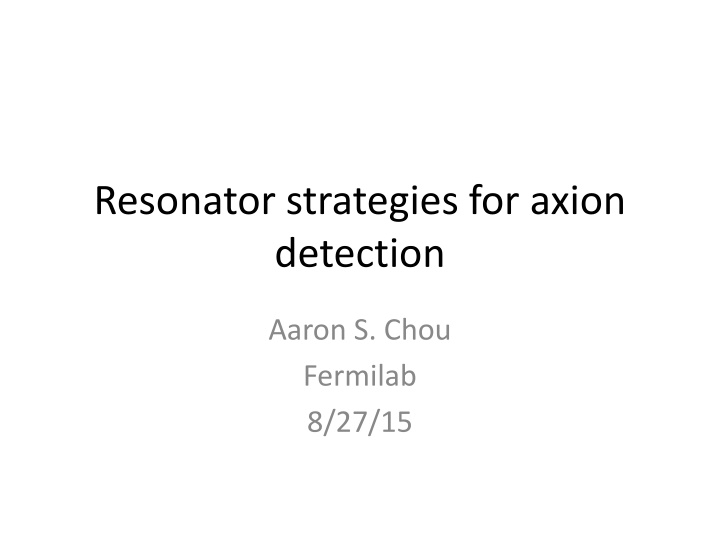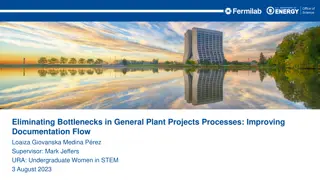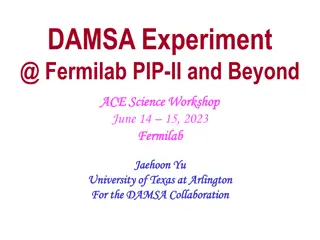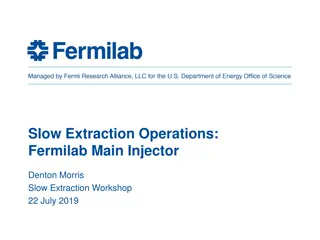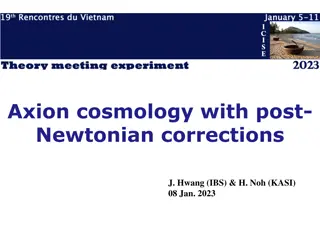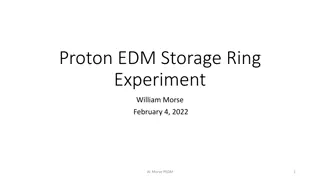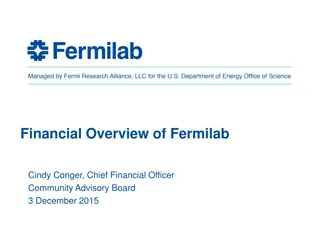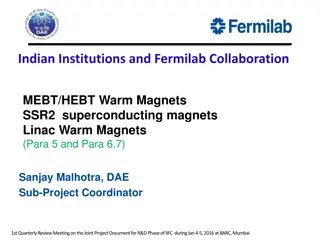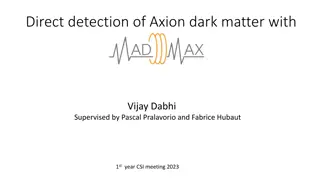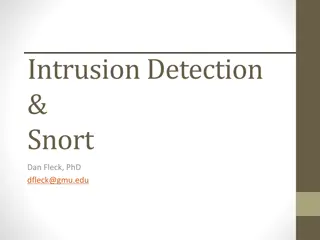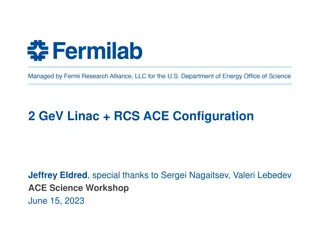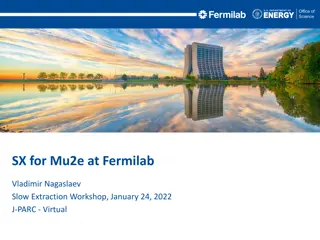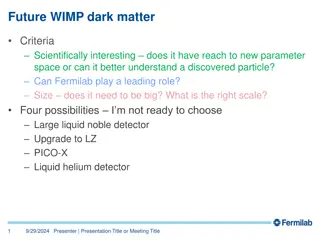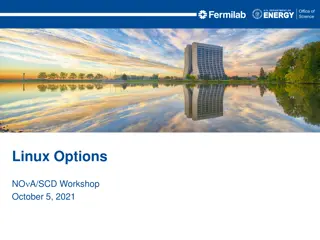Resonator Strategies for Axion Detection at Fermilab
The local axion dark matter behaves like a classical wave similar to a solid-state laser, with characteristics such as a huge number density and coherence time. Axion dark matter interacts with magnetic and electric fields, allowing for the conversion of energy into real photons. This innovative approach involves placing conductors strategically to absorb momentum and convert induced electric field oscillations into usable magnetic energy. The detection method involves narrowing down to the axion linewidth to improve signal-to-noise ratio, but challenges arise with increasing frequency. Integration time plays a crucial role in tuning antennas to scan for axion transmission frequency. This cutting-edge research by Aaron S. Chou at Fermilab workshop showcases novel techniques in axion detection using resonator strategies.
Download Presentation

Please find below an Image/Link to download the presentation.
The content on the website is provided AS IS for your information and personal use only. It may not be sold, licensed, or shared on other websites without obtaining consent from the author.If you encounter any issues during the download, it is possible that the publisher has removed the file from their server.
You are allowed to download the files provided on this website for personal or commercial use, subject to the condition that they are used lawfully. All files are the property of their respective owners.
The content on the website is provided AS IS for your information and personal use only. It may not be sold, licensed, or shared on other websites without obtaining consent from the author.
E N D
Presentation Transcript
Resonator strategies for axion detection Aaron S. Chou Fermilab 8/27/15
The local axion dark matter can be regarded as a classical wave with properties similar to those of a modern solid-state laser Huge number density, Linewidth kHz, Coherence time ms Except, we don t know the color of this mystery laser pointer, and it doesn t interact much with our detectors .. 2 Aaron S. Chou, LLNL workshop 8/27/15
Axion DM behaves as a coherent oscillation of the QCD angle The interaction then rotates magnetic fields into electric fields (and vice-versa), and magnetic dipoles into electric dipoles, etc. 3 Aaron S. Chou, LLNL workshop 8/27/15
Placing conductors at the appropriate spacing to absorb momentum then allows the induced E field oscillations to be converted to real photons Usable magnetic energy EM coupling Input signal Signal freq. Important observations: 1) The signal power is suppressed only by the QCD scale 4, not by fa 2) The signal power grows with mass ma The form factor Cnow contains all geometric factors including the cavity mode overlap integral, the magnet bore filling factor, maybe even the geometric factor in Q from volume/area ratio. Aaron S. Chou, LLNL workshop 8/27/15 4
Assuming copper cavities: Anomalous skin depth: Spherical cow cavity: Signal power now grows only weakly with frequency: Aaron S. Chou, LLNL workshop 8/27/15 5
Thermal noise We will narrow-band the detection all the way down to the axion linewidth. This improves signal/noise linearly with tuning time, up to the coherence time of the axion. (At this point the axion line is resolved and the signal power becomes split into neighboring bins each with longer coherence time). The in-band noise is then kT per resolved mode The signal/noise ratio is then: Not bad! But gets worse with increasing frequency. Aaron S. Chou, LLNL workshop 8/27/15 6
Integration time at each tuning Need to tune antenna to scan for the axion transmission frequency. If Psignal < Pnoise, need to average over many measurements to detect the small signal power excess. Integration time required at each tuning is given by the Dicke radiometer equation which parametrizes the sqrt(N) improvement: # samples needed Sample time e.g. if noise = 10x signal, need 100 samples to average down noise by factor of 10. Aaron S. Chou, LLNL workshop 8/27/15 7
Total integration time to cover an octave in mass Viewing the cavity as a bandpass filter, each tuning simultaneously measures Qa/Qcav bins. (i.e. by long integration times, we are resolving the Lorentzian bandpass of the cavity) Each tuning then covers a frequency range times. To cover an octave requires repeating the tuning Multiply by 9 for 3-sigma, multiply by 34=81 for DFSZ to get 12 days scan time. Aaron S. Chou, LLNL workshop 8/27/15 8
At 100 mK, the noise becomes quantum-limited above 2.5 GHz Noise = 1 photon per resolved mode Noise power now scales as f2 rather than linearly with f (!) The signal power still grows as f1/3, but is 7 times smaller with SNR now scaling very poorly as f-5/3 Aaron S. Chou, LLNL workshop 8/27/15 9
Compared to thermal-noise-limited searches, the quantum-limited search has much poorer frequency scaling Quantum-limited Thermal-limited Aaron S. Chou, LLNL workshop 8/27/15 10
Tuning times now scale so quickly with frequency that they must be explicitly integrated KSVZ coupling at 1-sigma Aaron S. Chou, LLNL workshop 8/27/15 11
Total integration times per octave for 3-sigma DFSZ sensitivity DFSZ has 3x weaker coupling than KSVZ, so multiply integration times by 81 3-sigma needs 9 times integration time per tuning Aaron S. Chou, LLNL workshop 8/27/15 12
Realistic expectations A likely factor of 3 in the total geometric efficiency will cost a factor of 10 in increased integration time 490 days 10 GHz is barely do-able in the context of ADMX G2 Aaron S. Chou, LLNL workshop 8/27/15 13
Realistic expectations A likely factor of 3 in the total geometric efficiency will cost a factor of 10 in increased integration time 1540 days 4900 days Above 10 GHz will *definitely* need a new magnet with a factor of 10 in energy stored in the bore. This is a $100M scale magnet! Even if we get such a magnet, to achieve C 0.25 will need innovative and efficient packing of resonator elements to fully utilize the magnetic energy. Aaron S. Chou, LLNL workshop 8/27/15 14
Even ADMX-HF fat tuning rod is not good enough with big UW ADMX magnet Geometric utilization C=0.12 gives: 1666 days to reach 10 GHz, 5240 days to reach 20 GHz. /2 = 1.5 cm DFSZ @ 3 sigma R = 25 cm 15 Aaron S. Chou, LLNL workshop 8/27/15
Rectilinear is better than cylindrical, but would still need an array to efficiently pack the bore lm = 1 m Not obvious how to tune frequencies. Multiple elements need complicated power combining. /2= 1.5 cm 16 Aaron S. Chou, LLNL workshop 8/27/15
Idea for tunable waveguide cavity S. Kazakov (FNAL) Aaron S. Chou, LLNL workshop 8/27/15 17
S. Kazakov (TD) For efficient coupling, the resonant mode must be aligned with the exotic current source. For example, bend the waveguide resonator whenever the electric field starts changing direction Aaron S. Chou, LLNL workshop 8/27/15 18
Tune frequency by moving opposite sides away from each other to change transverse boundary conditions Maintain high Q by covering gaps with high capacitance shorting plates. Aaron S. Chou, LLNL workshop 8/27/15 19
S. Kazakov (TD) Quality factor and form factor vs slot size Slt = 0.1mm F = 11.603 GHz, Q = 6414, C = 0.327 Slt = 10mm F = 10.087 GHz, Q = 1317, C = 0.416 Slt = 5 mm F = 10.814 GHz, Q = 6977, C = 0.364 Tunablity ~ 10% before leakage through slot significantly impacts Q. Shorting plates across slot improves Q by a factor of around 5. (cf. spherical cow Q = 3x104@ 10 GHz) Geometric form factor C is fairly good, at least for the cavity mode coupling. Aaron S. Chou, LLNL workshop 8/27/15 20
Efficient packing may be possible for a single, long snaking waveguide, filling the entire magnet bore. IKEA rug cavity or Aaron S. Chou, LLNL workshop 8/27/15 21
Big advantages of waveguide-based cavity: Only need to tune 1 continuous resonator, not N independent resonators. Strong coupling from 1 region to its neighbors good adiabatic tolerance for small geometrical fabrication errors. (A coax cable still works even if you accidentally step on it.) Power combining is not necessary since Poynting vector snakes around before arriving at ends of the waveguide. Geometry is scalable to higher frequencies Aaron S. Chou, LLNL workshop 8/27/15 22
Conclusions Thermal-limited ADMX G2 search up to 2.5 GHz is in good shape Reaching 10 GHz already requires innovative packing of resonators to fully utilize the full 4 MJ of energy in the ADMX magnet bore Going beyond 10 GHz will almost certainly require buying or borrowing a $100M scale magnet Even with a new magnet, scalable designs for efficient packing of resonators will be needed for higher frequency axion searches. Aaron S. Chou, LLNL workshop 8/27/15 23
